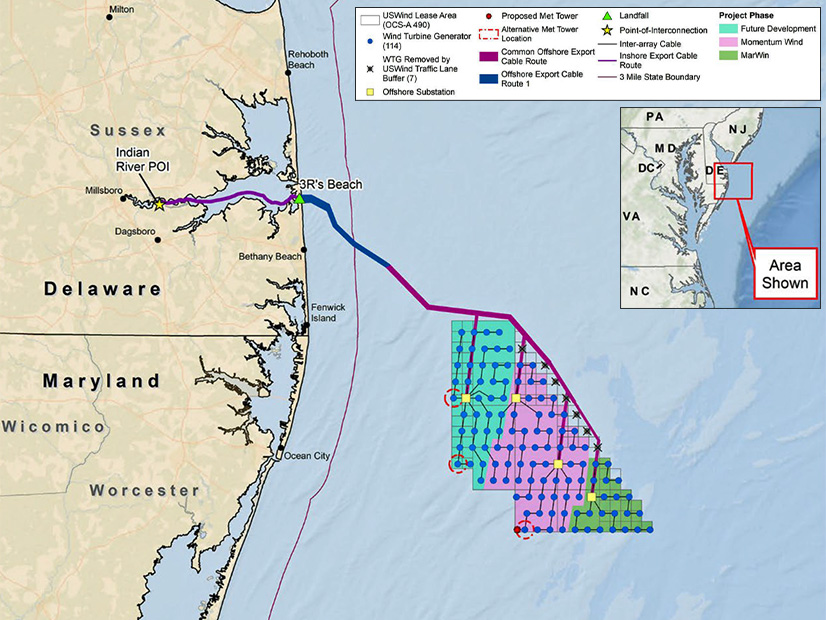
Federal regulators have completed their environmental review of a wind energy proposal off the Maryland coast, putting the US Wind project in line to be the 10th approved in U.S. waters.
The U.S. Bureau of Ocean Energy Management said July 29 that the plan could yield up to 2.2 GW of emissions-free electricity if built as proposed.
BOEM said it will post a notice of availability of the final Environmental Impact Statement on Aug. 2, triggering a waiting period of at least 30 days before it can issue a Record of Decision on the construction and operations plan submitted by US Wind.
All nine of the records of decision issued so far have been approvals.
US Wind is proposing a wind energy facility of up to 114 wind turbine generators rated at 14 MW to 18 MW each, up to four offshore substations and a meteorological tower on OCS-A 0490, an 80,000-acre lease area 10.1 miles off the northern Maryland coast. Seven of the original 121 turbine positions were deleted to create greater separation from Delaware Bay marine traffic.
The nameplate capacity would be as much as 2.2 GW, and that electricity would be exported to three substations to be built in Delaware.
The project includes MarWin, a 300-MW wind farm, and Momentum Wind, rated at 808 MW. Both hold offshore renewable energy credit (OREC) agreements with the state of Maryland. The remainder of the lease area would be built out in a third phase as additional demand arose.
BOEM made the environmental impact statement (EIS) public in draft form in October 2023 and received 1,833 comments in response.
The Maryland offshore wind final EIS follows a format similar to those issued for other projects, presenting a range of possible effects that construction and operation of the wind farms would have in a series of categories — sometimes positive, sometimes negative, sometimes both or neither.
For example, birds could have increased foraging opportunities once wind turbines were installed and they could be killed by spinning blades. Jobs might be lost in the recreation and tourism sectors and jobs would be created in the wind sector. Environmental justice populations would suffer some disruption and could benefit from new employment and economic activity.
The cumulative environmental impact with ongoing and future activities (including other offshore wind activities) also is predicted, and in some cases is more beneficial or more detrimental than the individual impact of one project.
The EIS also looks at the future result of the status quo — of not building wind farms in OCS-A 490 — and finds that in some categories, continuation of present environmental trends might be as detrimental in their own way as would be building wind farms intended to counter those trends by reducing greenhouse gas emissions.
The critically endangered North Atlantic right whale — poster cetacean for offshore wind opponents — is one such example.
The EIS estimates the project by itself would have minor negative impact on the whale but a major impact if considered in combination with existing baseline factors and environmental trends that would continue without construction of the facility.
As with the reports prepared for other projects, the Maryland offshore wind EIS foresees potential major impacts for commercial fisheries; scientific research and surveys; and visual resources.
MarWin and Momentum Wind are important pieces of Maryland’s strategy to reach its target of 8.5 GW offshore wind by 2031. Right now, they are the only pieces — Ørsted canceled the Maryland OREC contract for its two-phase 966-MW Skipjack project amid industrywide financial struggles. (See Ørsted Cancels Skipjack Wind Agreement with Maryland.)
In May, the state allowed US Wind to request contract revisions and higher compensation in an attempt to keep those two projects in the portfolio. (See Maryland Offers OSW Developer More Lucrative Terms.)
The Biden administration’s push for offshore wind development continues. BOEM has scheduled an auction Aug. 14 for wind lease areas off the Delaware, Maryland and Virginia coastline estimated to hold the potential for up to 6.3 GW of electric generation.
US Wind said July 29 that the EIS is a major milestone for its three-phase project, and said it expects BOEM to issue the record of decision in September.
CEO Jeff Grybowski said in a news release: “We are well on our way to putting Maryland’s offshore wind goals that much closer to reality. We applaud BOEM for the comprehensive and thorough review of our federal permit application. We are now one step closer to securing all of our federal permits by the end of this year, and look forward to the day we can get steel in the water.”
Italy’s Renexia SpA, a subsidiary of Toto Holding SpA, is majority owner of US Wind.
Trade association Oceantic Network said the pipeline of approved U.S. offshore wind proposals will exceed 15 GW once US Wind gets its record of decision, and it noted that more than 5 GW already is under construction.
CEO Liz Burdock highlighted the local and national relevance of US Wind in a news release:
“Maryland has long seen offshore wind power as a key part of its energy and economic future, investing in a local offshore wind supply chain and the development of robust clean energy targets that have been driving the industry forward since its early stages. Today, the state has a commercial scale project nearing full construction approval and is poised to become a regional hub for offshore wind manufacturing and steel fabrication. Along with US Wind’s direct investment in Sparrows Point Steel, this offshore wind project will contribute to new, well-paying jobs across Maryland and throughout the supply chain.”


